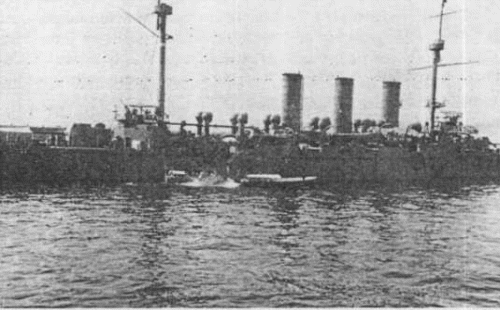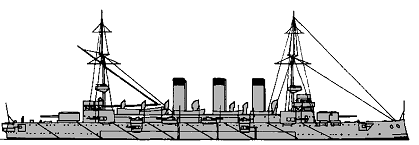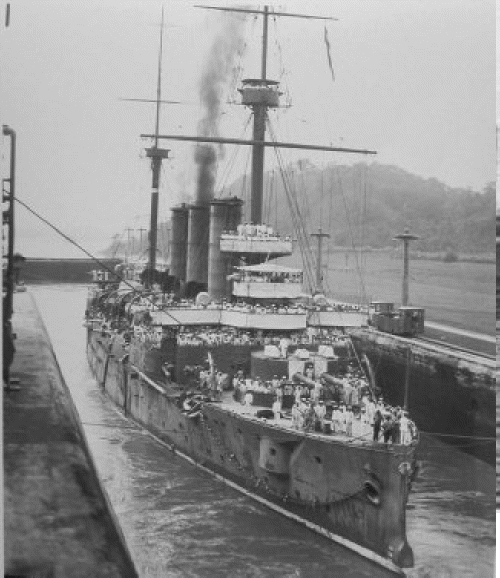
NAVYPEDIA
 Support the project with paypal
Support the project with paypal
Photo

Yakumo 1913
Ships
| Name | No | Yard No | Builder | Laid down | Launched | Comp | Fate |
|---|---|---|---|---|---|---|---|
| 八雲 [Yakumo] | 240 | Vulcan, Stettin, Germany | 3/1898 | 8.7.1899 | 20.6.1900 | surrendered 8.1945, BU 1947 |
Technical data
| Displacement normal, t | 9646 |
|---|---|
| Displacement full, t | 10300 |
| Length, m | 124.6 pp 132.3 oa |
| Breadth, m | 19.6 |
| Draught, m | 7.24 |
| No of shafts | 2 |
| Machinery | 2 VTE, 24 Belleville boilers |
| Power, h. p. | 15500 |
| Max speed, kts | 20.5 |
| Fuel, t | coal 1242 |
| Endurance, nm(kts) | 7000(10) |
| Armour, mm | belt: 178 - 89, bulkheads: 152, upper belt: 127, barbettes: 152, turrets: 152, casemates: 152 - 51, deck: 63 - 51, CT: 356 - 76, fwd torpedo room: 152 |
| Armament | 2 x 2 - 203/45 Armstrong U, 12 x 1 - 152/40 Armstrong Z, 12 x 1 - 76/40 Armstrong N, 7 x 1 - 47/30 21/2pdr Hotchkiss Mk I, 5 - 450 TT (1 bow, 4 beam) |
| Complement | 700 |
Standard scale images

Yakumo 1900
Graphics
Project history
Ordered under the Second Naval Expansion Programme of 1896-1897, when Japan turned to a German yard for assistance. (Previously Germany had been closely involved in constructing warships for China, Japan's recent enemy.) The protection of the Yakumo was well designed. A total of 247 watertight compartments were provided, 38 of them being in the double bottom. Although the ship was built in a German yard, the Japanese stipulated that she be armed with British manufactured Elswick guns to ensure ammunition compatibility with all her other major warships.
Ship protection
Main 178mm belt had 68.4m length (inside barbettes) and 2.1m height, closed by 152mm bulkheads abreast barbettes. Its thickness was 89mm outside barbettes. Upper 127mm belt had dimensions 61.6x2.1m. 51mm deck was connected with lower edge of main belt by 76mm slopes. It has turtleback form and 63-51mm thickness outside barbettes. CT had 356mm sides and 76mm roof. All 8`` and 6`` guns and fore torpedo room had 152mm protection (but 4 6`` guns amidships were protected by only 51mm armor).
Modernizations
1924: - 4 x 1 - 76/40, 4 x 1 - 47/30, 3 - 450 TT; + 1 x 1 - 76/40 3-shiki
1927: boilers were replaced by 6 Yarrow (oil- and coal-burning), engine power decreased to 7000hp and maximal speed to 16kts; - 4 x 1 - 152/40, 8 x 1 - 76/40, 3 x 1 - 47/30, 2 - 450 TT
1945: - 2 x 2 - 203/45, 4 x 1 - 152/40; + 2 x 2 - 127/40 89-shiki, 2 x 3 - 25/60 96-shiki, 2 x 2 - 25/60 96-shiki, 2 x 1 - 25/60 96-shiki
Naval service Actively participated in war against Russia in 1904-1905. In September, 1921 Yakumo was reclassified to 1 class coast defence ship but further served as TS. In July, 1942
Actively participated in war against Russia in 1904-1905. In September, 1921 Yakumo was reclassified to 1 class coast defence ship but further served as TS. In July, 1942 Yakumo again became 1st class cruiser, however she did not participate in operations. She was used for repatriation after war and stricken in July 1946. Ship was sold for scrap in June, 1946.
Many thanks to Wolfgang Stöhr for additional information on this page.
 HOME
HOME FIGHTING SHIPS OF THE WORLD
FIGHTING SHIPS OF THE WORLD JAPAN
JAPAN CRUISERS
CRUISERS YAKUMO armoured cruiser (1900)
YAKUMO armoured cruiser (1900)

